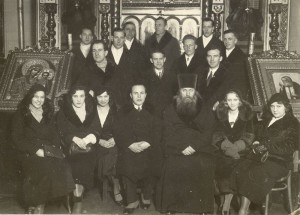The Old Believers of Riga
Arnold Podmazov
The Years of Prosperity and the Years of Misery: Riga’s Old Believers in the 19th Century
During the War of 1812 on the basis of a report about the approaching of Napoleon’s army (false one, as it later turned out), the suburbs of Riga were burnt down. The fire also destroyed the Old Believers’ community church. Nevertheless, already in 1814, Riga’s Old Believers already built a new brick building, a larger and a statelier one, which, according to one of the high-ranking Tsarist officials, had “high ceilings, was decorated with a beautiful iconostasis, a marvelous chandelier, places for the choir, and quite decent church accessories.” In everyday parlance and in official documents this house of prayer was called the “big stone church.”
Beside the “big stone church,” the Moscow suburb (today, Riga’s Latgale suburb) had another church, the so-called “Pushkov’s” house of prayer, named after a merchant who founded it. It had perished in the fire of 1812 and was rebuilt in 1814. Today, the Archangel Michael Orthodox church stands at this place (170 Maskavas Street). The third house of prayer was set up in Petersburg suburb of Riga in 1809, at the house of the II Guild merchant K. Panin. This house of prayer was also damaged by fire in 1812 and later rebuilt.
The “big stone church” contained an almshouse, which, according to the 1829 report, accomodated 244 people, a hospital with 73 patients (as of 1829), and orphanage with 71 children. Besides the main almshouse, in 1820s in Riga there were other almshouses in Riga, – not less than four, according to official reports.
The “big stone” house of prayer also had a school with 110 boys and girls, 75 of them living in residence. The education for the children from poor families was free of charge.
In the beginning of the 19th century, various kinds of workshops operated under the auspices of the “big stone” church, painting icons, making candles, clothes etc. Experienced scribes were engaged in copying ecclesiastical books.
In 1806, a merchant K. Khlebnikov bought the Grizenberg estate, which he later transferred into the hands of the Old Believers’ community, while receiving a considerable profit.
The extensive economical activity of Riga’s Old Believers required capable and efficient management. Therefore, at the turn of 18th and 19th centuries the Statutes were put together (only fragments of which have survived to this day). The next Statutes were adopted by Preobrazhenskaya Fedoseyevian Community in 1812 under the title “The Articles for the Church Organization.” These were compiled with the participation of Riga’s Old Believers who themselves adopted these Statutes in 1813. Some time later the community adopted “Regulations for the Management of the Almshouse, Hospital, Orphanage, and the School of the Riga Old Believers’ Community.” This was a voluminous document consisting of 14 chapters, 25 articles and 163 paragraphs, the content of which exceeded the limits set by the title, as it regulated all aspects of life for Riga’s Old Believers.
In 1827 the Statutes of Riga’s Old Believers were approved by the Governor General of Riga, Marquess Philip Paulucci (1779–1849, Governor General in 1813–1830) and became the official legal document, upon which Riga Old Believers based the management of their common property.
Having strong position in local economy, Old Believers had gained experience dealing with local authorities, and became skillful diplomats. During the first quarter of the 19th century, mainly due to their dynamic economic activity, the population of Old Believers was on the increase. If in 1816 there were 2112 Old Believers living in Riga, in 1826 this number increased to 5424, but in 1830 it reached 7904.
Emperor Nicholas I (1796–1855, reigned in 1825–1855) having brutally suppressed the Decembrist revolt, began an aggressive campaign against any semblance of opposition movement, in secular, as well as in religious sphere. Soon, this change of policy had full impact upon Riga Old Believers. It is in 1830s that the history of Old Believers in Riga saw its darkest and most tragic period.
In 1833 by the order of the Ministry of the Interior, the Statutes, earlier approved by Marquess Paulucci, were revoked, thus depriving the Old Believers’ community of any legal basis for its activity. The almshouse and hospital were placed under the jurisdiction of the Livland Department of Public Welfare. The orphanage was closed: boys were transferred to the Riga cantonist batalion, while girls were sent “to reputable places and charitable institutions,” that is, to the convent. In the same year, Riga Old Believers were ordered from then on to call their community “Grebenshchikov,” by the name of a trustee, a merchant Alexey Grebenshchikov (who by then was already deceased) instead of Uspenskaya (Dormition), by the name of the church. Despite all protests of the community’s trustees, the Interior Minister D. Bludov (1785–1864) signed the decree to change the name of the Riga community, referring to the emperor’s own opinion.
The repressive policies of 1830s–50s were a harsh blow for the interest of the Old Believers’ merchants. In 1847 the government issued a decree, forbidding admittance of the Old Believers into the merchant guilds. From January 1834, Old Believers were forbidden to keep registrar books. Previously, excerpts made from these books were written on official letterhead and certified with a seal, and thus were regarded as legal documents. Since the authorities recognized only an officially registered church marriage as valid, the children of the Bespopovtsy Old Believers fell into the category of the illegitimate and could not have been registered under their fathers’ names. De facto, the law did not recognize the paternity. As a result, those traders, who were bound to run a legitimate business, encountered problems with regards to leaving and receiving inheritance. As the children of merchants were deprived of the right to inherit either their father’s name, or his title, the law forbade them to become traders themselves.
Not putting stock into repressive policies alone, in 1832 the Holy Synod sent to Riga an experienced missionary G. Kuninsky to establish in the city a edinoverie church. Edinoverie (‘one faith’) was an artificial ecclesiastical creation, founded in order to seek the union between the Old Believers and the official Orthodox Church. The so-called “Articles on the United Faith” were edited by Moscow Metropolitan Platon (Levshin, 1737–1812) and approved by the Emperor Pavel I (1754–1801, Emperor since 1796) in October 1800. After converting into edinoverie, Old Believer communities were supplied with Orthodox priests who served the liturgy using the pre-reform (“pre-Nikonian”) books and retained old rituals. All edinoverie parishes were subject to the jurisdiction of the official Orthodox church. Riga Old Believers firmly stood against edinoverie. Despite massive efforts of the authorities, attempts to persuade, and open threats, G. Kuninsky’s mission turned out to be a failure and in March of 1833 he had to resign and leave Riga under the pretext of illness.
It became absolutely clear to the Tsarist government, that without strengthening the Orthodox Church in the Baltic region, any attempt to oppose the Old Believers’ church will fail. It is in order to bolster the official Orthodoxy that in 1836 the Synod established the Vicariate of Riga with an auxiliary bishop of Riga under the jurisdiction of the bishop of Pskov. In 1850 the Vicariate was transformed into an independent Diocese of Riga.
The first Orthodox auxiliary Bishop Irinarkh (Popov, 1790–1877) who arrived in Riga in 1836, tried to promote the government policy. Some of the prosperous Old Believers saw edinoverie as a possibility for a formal legalization of their property rights. Already in 1836, four merchant families expressed their desire to convert to edinoverie, while the trustees of the Old Believers’ community, pressured by the Governor General, handed the Pushkov’s house of prayer to the city authorities, so that a church of edinoverie may be established there. The introduction of edinoverie in Riga was accompanied by intense internal struggle within the Old Believers’ community. By the time the edinoverie church was dedicated in July of 1837, its parish included of approximately twenty merchant families.
At the same time with the imposition of edinoverie, the government was closing down the Old Believers’ prayer houses everywhere (in the terminology of those times, it was “sealing the prayer houses”). In case when the Old Believers’ parishes were small, the authorities closed them down quite easily. The situation was more difficult with the large Riga community that was highly esteemed among the Old Believers outside the territory of Latvia and thus was like a thorn in the flesh for the Tsarist government. It was impossible to close down this church without a serious reason. Nevertheless, the Riga Governor General Alexander Suvorov (1804–1882, the Governor in 1848–1861) had attempted to close down the Grebenshchikov praying house, on some formal pretext. Using eyewitnesses’ accounts, Russian writer Nikolay Leskov gave a thorough description of the events that transpired. When in April 1859 the Riga Police Chief himself and other policemen had arrived to put the seals on the doors of the church, a large crowd of Old Believers gathered around. The rafters who worked near the church arrived at the scene equipped with crooks and axes. The church and adjacent community buildings were surrounded by a high wall, behind which the multitude of people stood, ready for action. The police had to leave, but the army was summoned instead. Governor Suvorov himself arrived. The situation got almost out of control, people started to pick up rocks, there were threats against the Governor General. It was clear that the bloodshed would be inevitable. The Governor General did not want to allow this, and, therefore, he had to comply with the Old Believers’ wishes and to renounce his order to seal up the praying house. The Old Believers suffered punishments, but in the end they had managed to defend their house of prayer.
Content
- Introduction
- Schism and “Old Belief”
- Beginnings of the Old Believers on the territory of Latvia
- Confessional Characteristics of Old Believers in Latvia
- Old Believers’ Church Building and Liturgy
- Books and Book Culture
- Iconographic Traditions of Riga Old Believers
- Pomorian Old Believer Traditions of the Art of Copper Casting
- Old Believer Churches in Riga
- Old Believer Societies in Riga
- Old Russian Residents of Riga and Old Believers in the 18th century
- The Years of Prosperity and the Years of Misery: Riga’s Old Believers in the 19th Century
- Riga Old Believers at the Turn of 19th and 20th Centuries
- Riga Old Believers in the Independent Latvia (1918–1940)
- Riga Old Believers During the Soviet Period (1940–1941, 1944–1991)
- Riga Old Believers after the Restoration of Latvia’s Independence
- Photogallery
- About the Project. The Old Believers of Riga: 250 Years of Cultural Historical Experience







